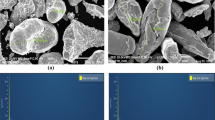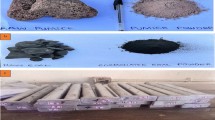Abstract
Optimization is proved proficiency method, which is used for finding required process conditions to give the maximum or minimum value of the function. A new metal based alloy with a defined composition of Copper (84 %) Aluminium (12 %) Nickel (4 %) is proposed. The powder has synthesized by a powder metallurgy process for the production of near net-shaped components through mechanical alloying. It is more complex to attain the properties in the making of materials for marine applications. The main objective of this study was to obtain an alloy compact with high density and hardness and consider a set of optimal process parameters like sintering temperature, holding time and compaction pressure. The alloy has a set of desired properties to suit the needs of the marine applications, porous material filters and electric friction equipments. The combination of Cu–Al–Ni offered in marine applications like rotary hydraulic actuator, hydraulic tube due to high mechanical strength, good corrosion resistance. Copper, Aluminium and Nickel powders are mixed by ball milling equipment and compacted at pressures 550, 590 and 630 MPa using Universal Testing Machine (UTM). These compact specimens have been sintered in an electric muffle furnace at temperatures 640, 695 and 750 °C at different holding times of 30, 60 and 90 min. The L9 orthogonal array was designed with the combination of input factors and their levels. The experiments were conducted at each level to measure the maximum hardness and density. Grey Relational Analysis was applied to find the optimum input parameter configuration. ANOVA was adopted to determine the level of significance of input factors. Confirmatory experiments were done to verify the optimal results.
Similar content being viewed by others

References
G.S Upadhyaya, Powder Metallurgy Technology, Department of Materials and Metallurgical Engineering, IIT Kanpur, ISBN 1 898326 40 1.
W.A Monteiro, J.A.G Carrio (2010) Structural and Electrical Properties of Copper-Aluminium-Nickel alloys obtained by Conventional Powder Metallurgy Method, Material Science, Vols 660–661, pp 41–45.
Martina Hafner, Wolfgang (2015) Aluminium-Copper-Nickel Thin film compositional spread Nickel influence on fundamental alloy Properties and Chemical Stability of Copper, Material Science, Thin solid films 580, 36–44.
P.Wenschot (1997) A New Ni-Al Bronze alloy with Low Magnetic Permeability, Metallurgical and Materials Transactions, Volume 28A, 689.
S. Ahmad, N. Muhamad (2009) Taguchi Method for determination of optimised sintering parameters of Titanium alloy foams, International Advances in Materials and processing Technologies, Vol 53.
Apiwat Rittapai1, SomchaiUrapepon (2014) Properties of Experimental Cu-Al-Ni alloy for Dental post and Core Applications, Journal of Advanced Prosthodontics, Volume 6.2, 15–23.
Venkata Rao. R., Advanced Modelling and Optimization of Manufacturing Processes, Springer. 2011.
Lin, Z.C., Ho, C.Y (2003)Analysis and application of grey relation and ANOVA in chemical-mechanical polishing process parameters, International Journal of Advanced Manufacturing Technology, Vol. 21, pp. 10–14.
M. Kaladhar (2012) Determination of optimum process parameters during turning of AISI 304 Austenitic Stainless steels using Taguchi method and ANOVA, International Journal of Lean Thinking, Volume 3, Issue 1.
J.Crane, J.Winter (1986) Copper – Properties and Alloying, Material Science and Engineering, Vol 2, p. 848–855.
ASM Specialty Handbook (2001) Copper and Copper alloys, Metals, Chapter 1 section 1, 56–60.
S.M. Tang, C.Y. Chung (1997) Preparation of Cu-AI-Ni-based Shape Memory Alloys by Mechanical Alloying and Powder Metallurgy Method, Journal of Materials Processing Technology 63, 307–312.
W.A. Badawy, M.M Rabiee (2010) Effect of Ni Content on the electrochemical behaviour of Cu-Al-Ni alloys in Chloride free neutral solutions, Chemical Engineering Act 56, 913.
M. Gojie, L.Vrsakovic (2011) Electrochemical and Microstructural Study of Cu-Al-Ni shape memory alloy, Material Science and Design, Compd 509, 9782.
S. Raghuraman, K.Thiruppathi (2013) Optimization of EDM Parameters using Taguchi Method and Grey Relational Analysis for Mild Steel IS2026, IJIRSET Vol 2, Issue 7.
Sachiko Masuoka, Yosiro (2008) Preparation of well sintering Cu-Al powders and Properties of its sintered compacts, Japan Society of Powder Metallurgy, Volume 55, Number 6.
G.M. Le a, A. Godfrey a, N. Hansen (2013) “Structure and strength of aluminium with sub-micrometer/micrometer grain size prepared by spark plasma sintering”Materials and Design 49, 360–367.
Guoqiang Xie, Wei Zhang (2006) “Fabrication of porous Zr–Cu–Al–Ni bulk metallic glass by spark plasma sintering process”Scripta Materialia 55,687–690.
Mohitsharma, sanjaykumar (2010) “Processing and Characterization of Cu-Al-Ni Shape Memory Alloy Strips Prepared from Elemental Powders via a Novel Powder Metallurgy Route” The Minerals, Metals & Materials Society and ASM International.
Acknowledgments
It is my pleasant duty to express a deep sense of gratitude to the Management of SASTRA for providing us to carry out this research works in our University campus.
Author information
Authors and Affiliations
Corresponding author
Editor information
Editors and Affiliations
Rights and permissions
Copyright information
© 2017 Springer Science+Business Media Singapore
About this paper
Cite this paper
Abirami, Thiruppathi, K., Raghuraman, S. (2017). Investigations on the Influence of Mechanical Behaviour of Copper Aluminium Nickel Powder Compacts Processed Through Powder Metallurgy. In: Bajpai, R.P., Chandrasekhar, U. (eds) Innovative Design and Development Practices in Aerospace and Automotive Engineering. Lecture Notes in Mechanical Engineering. Springer, Singapore. https://doi.org/10.1007/978-981-10-1771-1_31
Download citation
DOI: https://doi.org/10.1007/978-981-10-1771-1_31
Published:
Publisher Name: Springer, Singapore
Print ISBN: 978-981-10-1770-4
Online ISBN: 978-981-10-1771-1
eBook Packages: EngineeringEngineering (R0)



